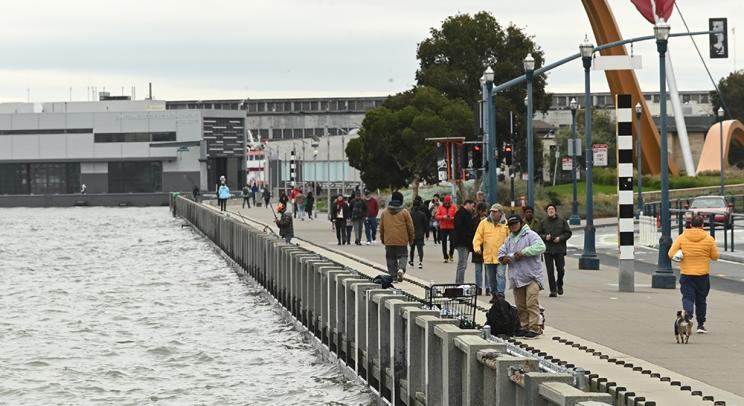
The San Francisco Bay has 400-miles of low-lying shoreline made up of diverse communities, extensive transportation infrastructure, unique ecological features and other key assets like waste-water treatment facilities and power plants. These places are vulnerable to increased flooding and sea level rise due to climate change, further compounded by socio-economic vulnerabilities fomented by income and wage inequalities and longstanding racial inequities. A resilient Bay Area requires the implementation of strategies at the local and regional scale that can achieve multiple benefits at once such as by addressing current vulnerabilities resulting from the housing affordability crisis while preparing for displacement caused by sea level rise, flooding, seismic events or wildfires.
BARC recognizes that we need to manage the uncertainties and physical hazards associated with the Bay Area’s geographic setting and changing climate. We can do that by implementing multi-benefit strategies that strengthen vulnerable people and communities, critical infrastructure, and the natural environment. We continue to stay involved in several sub-regional adaptation efforts that sprung from the Resilient By Design Bay Area Challenge--see side bar, under Resilient Bay Area. We are currently working on two initiatives identified in the BARC Shared Work plan that advance a Resilient Bay Area:
Shared Work Plan Initiative 1 – Develop a Regional Multi-Hazard Adaptation Plan
The goal of this initiative is to develop a mechanism through which regional agencies can better align, integrate and orient efforts so that cities, counties, special districts and communities have the tools they need to manage risks to climate hazards via a range of strategies. BARC is working with partners and stakeholders from across the Bay Area region to develop a Regional Multi-Hazard Adaptation Plan that supports the deployment of effective planning approaches and equitable, multi-benefit climate adaptation projects at the appropriate geographic scale across the San Francisco Bay Area.
The first phase of this effort is conducting a Systems-Thinking Analysis to outline and understand the distinct roles the regional agencies that comprise BARC currently play – or could play – in managing climate hazards such as drought, heat, wildfire, sea level rise and flooding. The analysis will illustrate how the regional agencies intersect with state and federal government on one end, and cities, counties and special districts, and other stakeholders on the other.
Year One Priorities and Tasks (supported by BARC staff, consultant, partners) include:
- Outline the landscape of powers, authorities and responsibilities among regional agencies related to multiple hazards and relationship to federal, state, and local/community roles and responsibilities.
- Understand permitting and regulatory landscape and impact on approving implementation of multi-benefit climate adaptation projects, including green, gray and hybrid projects.
Shared Work Plan Initiative 2 – Develop a Regional Technical Assistance Program
A coordinated Regional Climate Adaptation Technical Assistance program can identify the most effective ways in which regional agencies can support cities, counties, special districts, and community-based organizations in conducting actionable adaptation planning and project implementation. This initiative recognizes that climate adaptation and resilience planning and projects will most often need to happen at the local and/or sub-regional level, with regional and state agencies best positioned to provide needed support, resources, and guidance. Across the Bay Area, local governments have highly variable levels of capacity and resources available to conduct adaptation planning that is focused in identifying and deploying effective risk management strategies. Additionally, a special focus must be given to historically underserved Black, Indigenous and other communities of color who are at the frontlines of risk and already are battling challenging environmental conditions in their neighborhoods.
BARC sees the need for a clearinghouse or “storefront” of adaptation data, standards, and guidance, as well as straightforward and easy-to-access technical assistance for local governments and community-based organizations. With a focus on leveling the playing field, the regional agencies may need to deploy more intensive, hands-on support to local jurisdictions to help build greater resilience in every Bay Area community facing risks from climate hazards.
Year One Priorities and Tasks (supported by BARC staff, consultant, partners, and stakeholders) include:
- Conduct analysis to capture different types of technical assistance provided by regional and state agencies, identify gaps in service and support, understand lay of the land in terms of technical support needs, and who is best positioned to do what at all scales.
- Outreach/Engagement/Survey to determine needs for technical assistance by local stakeholders.
Did You Know
The 2018 State of California Sea-Level Rise Guidance projects that the San Francisco Bay is expected to rise another 12-32 inches by mid-century
What is Resilience?
Resilience is defined as the ability to recover from setbacks, adapt well to change and keep going in the face of adversity.
– Harvard Business Review
